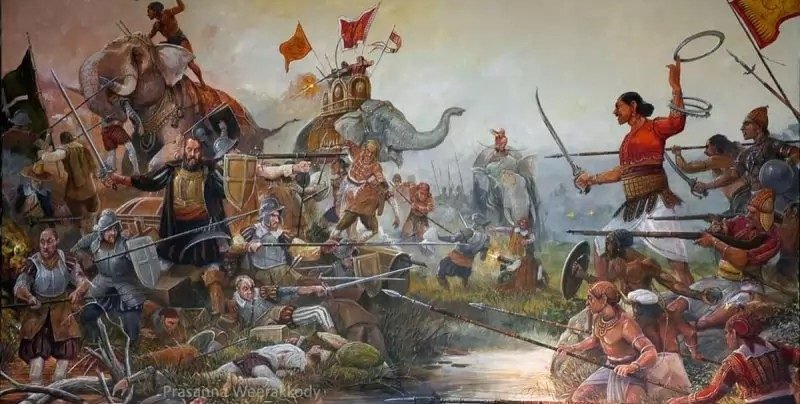
Kandy, During Portuguese Colonial era

Kandy City During the Portuguese Colonial Era
In the heart of Sri Lanka, the city of Kandy stood as a beacon of resilience and power during the Portuguese colonial era. Under the reign of King Senasammatha Wickramabahu, the Kandyan Kingdom expanded its borders to encompass a vast array of territories, including Siduruwana, Balavita, Sarasiya Paththuwa, Matale, Atasiya Paththuwa, Godarata, Mathurata, Uva, Atapodiya, Sorabora, Vellassa, Kothmale, Gampola, Dolosbage, Bulathgama, Mahathota, Trincomalee, and Batticaloa.
In 1472, his accomplishments were immortalized in a stone script at Gadaladeniya, which declared his successful conquest of Sathkoralaya and the addition of Kalutara to his kingdom. Despite these achievements, the city of Kandy faced relentless threats from the kings of the Kotte Kingdom and the Seethawaka Kingdom. To safeguard his realm, the Kandyan King sought an alliance with the Portuguese, who were eager to expand their influence and spread Catholicism.
The Portuguese Alliance
King Jayaweera, who ruled Kandy from 1511, agreed to pay taxes and convert to Catholicism in exchange for Portuguese support. During this period, Menawara Thunaya, a nephew of Dodamwela Parakrama Epa, governed Udarata with Pallepitiya as his capital. By 1494, he had expanded his territory to include Gampola-Siduruwana, Balanvita, Mathalaya, Pansiyapaththuwa, and Uva. However, King Parakramabahu VIII of Kotte eventually captured these regions, and the local chiefs, including Menawara Thunaya, submitted to the Kotte Kingdom. Menawara Thunaya was later appointed as King Thunayama and ruled Kandy as a tributary to the Kotte Kingdom.
Shifting Power Dynamics
After the reign of King Thunayama, a prince from the lineage of King Senasammatha Wickramabahu ascended the throne as Jayaweera II in 1514. He secured support from both the Kotte King and the Portuguese and married a Kotte princess. However, in 1542, the chiefs of Kandy ousted Jayaweera II and crowned Prince Rankodi Pathirannehelage, the son of King Thunayama, as Weera Parakramabahu. During his reign, he constructed the Poyamalu Viharaya and held a significant ordination ceremony at Getambe with the participation of 500 monks. He also appointed Ven. Devalegala Rathanasara as the chief monk in 1564. His reign concluded with his death in 1579.
The Portuguese Return
Following Weera Parakramabahu’s death, Karalliyadde Bandara, the son of Jayaweera II, reclaimed the throne in 1580 with Portuguese assistance, taking the name Jayaweera III. A devout Catholic, he baptized his eldest daughter as Dona Margarida and married her to King Dharmapala of Kotte. However, tranquility was short-lived as King Rajasinghe I, the son of King Mayadunne of Sitavaka, captured Kandy in 1582, driving Karalliyadde Bandara into exile. The Kandyan chiefs, led by Virasundara Mudali, supported Rajasinghe I due to their disdain for Karalliyadde Bandara’s Catholicism.
The Rise of Konappu Bandara
After being driven out, Karalliyadde Bandara sought refuge with the Portuguese, taking his daughter Kusumasana Devi and nephew Yamasinghe Bandara. They were baptized as Dona Catherina and Don Phillip respectively. Karalliyadde Bandara passed away in exile. Meanwhile, King Rajasinghe I’s tyranny incited significant unrest in Kandy. He later killed Virasundara Mudali in a conspiracy, prompting Virasundara’s son, Konappu Bandara, to flee to the Portuguese.
The Final Struggle
The oppressive rule of King Rajasinghe I led to widespread discontent. When news broke of his plans to attack Colombo Fort, the Portuguese dispatched an army led by Konappu Bandara (alias Don Juan) to the hill country. They placed Yamasinghe Bandara (alias Don Phillip) on the throne, marking another chapter in the tumultuous history of Kandy during the Portuguese colonial era.
Thus, the city of Kandy, amidst alliances, betrayals, and foreign influence, remained a testament to the resilience and strategic prowess of its rulers during the Portuguese colonial period.

Onela Meerwald
15/09/2021 at 08:41wow